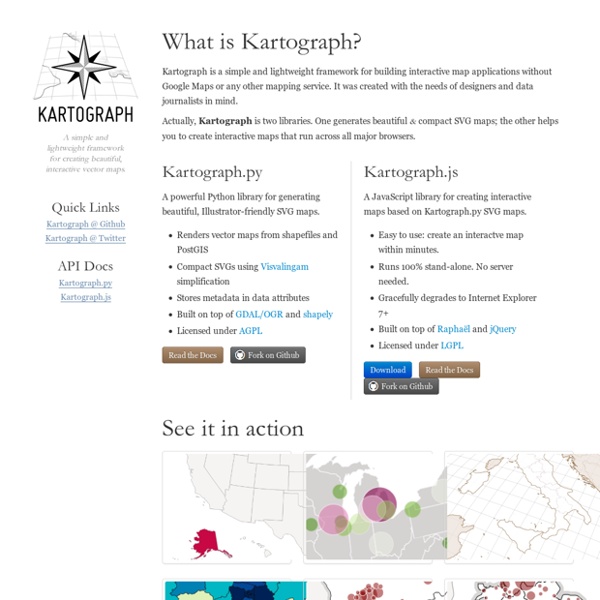



Map Projections: Flatten the Sphere - GIS Geography Why use map projections? The best way to represent the Earth is with a globe. We live on one big blue marble that’s the shape of a sphere (or close to it) But globes are hard to carry in your backpack, you can only see one side of the globe, it’s hard to measure distances and they’re just not as convenient as paper maps. This is why we project globes on two-dimensional planes with map projections. For the GIS analyst to make use of points, lines and polygons, it is necessary to locate them in two dimensions. Processing.js This page tries to explain how to quickly and (as) correctly (as possible) use Processing sketches on webpages. The information is based on the work done by the processing.js group. This information on this page reflects the best of my knowledge anno November 2010, and processing.js becomes more and more complete, so it is possible that the information on this page changes over time. Should you spot any incompletenesses or blatant mistakes, please contact me at pomax at nihongoresources.com, with the obvious substitutions in place to make it a legal email address. What is Processing?
Weka 3 - Data Mining with Open Source Machine Learning Software in Java Weka is a collection of machine learning algorithms for data mining tasks. It contains tools for data preparation, classification, regression, clustering, association rules mining, and visualization. Found only on the islands of New Zealand, the Weka is a flightless bird with an inquisitive nature. The name is pronounced like this, and the bird sounds like this. Weka is open source software issued under the GNU General Public License. We have put together several free online courses that teach machine learning and data mining using Weka.
Thinkmap SDK The Thinkmap SDK enables organizations to incorporate data-driven visualization technology into their enterprise Web applications. Thinkmap applications allow users to make sense of complex information in ways that traditional interfaces are incapable of. The Thinkmap SDK (v. 2.8) includes a set of out-of-the-box configurations for solving common visualization problems, as well as new visualization techniques for customizing data displays. We have designed Thinkmap to be lightweight, fast, easily extensible, and able to connect seamlessly to a wide variety of data sources.
Interaction online How do web maps work? Maps are more than just streets, markers, and labels. In this guide, learn the guts of how your computer downloads and displays maps. Getting started with Mapbox.js Meet Mapbox.js - the toolset for creating interactions and greater customization of your map and data. Boston public schools map switch aims to amend 500 years of distortion When Boston public schools introduced a new standard map of the world this week, some young students’ felt their jaws drop. In an instant, their view of the world had changed. The USA was small. <div> HTML Tag » Element of HTML Document Structure What does <div> HTML Tag do? The <div> element defines an arbitrary block of content which can be placed and styled as a single unit. Display block
Tangle: a JavaScript library for reactive documents Tangle is a JavaScript library for creating reactive documents. Your readers can interactively explore possibilities, play with parameters, and see the document update immediately. Tangle is super-simple and easy to learn. This is a simple reactive document. When you eat 3 drag StatPlanet StatPlanet (formerly StatPlanet Map Maker) is a free, award-winning application for creating fully customizable interactive maps. StatPlanet can be used to visualize location-based statistical data, such as life expectancy by country or demographic statistics and voting patterns by US state. In addition to maps, StatPlanet also has the option of including interactive graphs and charts to create feature-rich interactive infographics.
5 things to know before choosing digital maps API: Google Maps Vs Mapbox explained. The on demand economy is no longer a fad. It is here, there, everywhere! This is not a sudden change, but one that has happened, and still happening gradually, powered by the collusion of numerous factors that have all come together to make our life easier – one tap to get everything under the sun, at your door. Indeed, sounds like a genie! Your maps are not lying to you – Medium Or, your maps are lying to you but so would any other map. A week or two ago [edit: by now, sometime last year] a journalist must have discovered thetruesize.com, a nifty site that lets you explore and discover how sizes of countries are distorted in the most common world map, and thus was born another wave of #content in the sea of web media. Your maps are lying to you!
Build Truly Native Mobile Apps with Vue NativeScript and Vue.js The lightweight nature of Vue.js makes it perfect for mobile development. In addition, if you are already a Vue developer, much of the Vue syntax and app architecture will seem very familiar. All you need to do in a NativeScript-Vue app is switch the plugin you include at the start, change your app instantiation parameters, and write your front-end templates to use NativeScript modules, rather than web markup. Here are the three main differences between Vue.js for the web, and NativeScript-Vue: Crossfilter Fast Multidimensional Filtering for Coordinated Views Crossfilter is a JavaScript library for exploring large multivariate datasets in the browser. Crossfilter supports extremely fast (<30ms) interaction with coordinated views, even with datasets containing a million or more records; we built it to power analytics for Square Register, allowing merchants to slice and dice their payment history fluidly.